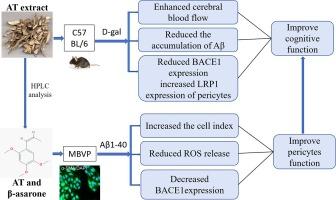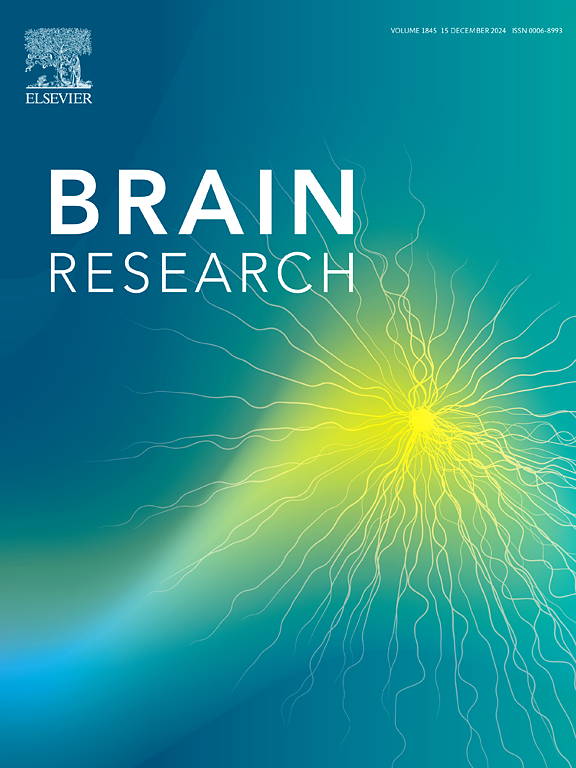石菖蒲能缓解 D-半乳糖诱导的阿尔茨海默氏症样疾病小鼠认知障碍和 Aβ 诱导的周细胞功能障碍。
IF 2.7
4区 医学
Q3 NEUROSCIENCES
引用次数: 0
摘要
周细胞调节脑血流(CBF)和大脑中过量的淀粉样蛋白。周细胞功能障碍可能会导致阿尔茨海默病(AD)的病理变化。唐菖蒲(AT)是一种常用于治疗阿尔茨海默病的中药,可保护中枢神经系统。然而,AT是否能调节周细胞功能并改善认知功能障碍仍不清楚。我们采用了一种新颖的靶点识别测试、CBF定量测量、苏木精和伊红染色、免疫荧光染色以及Western印迹来研究AT在改善AD患者认知功能方面的作用。此外,我们还利用透射电子显微镜、银染色、电阻抗等方法研究了AT中的主要活性化合物β-Asarone通过调节周细胞功能治疗AD的治疗潜力。结果表明,服用AT能有效缓解D-半乳糖诱导的小鼠认知障碍,具体表现为CBF增强、受损脑组织细胞的组织学特征改善、血小板衍生生长因子-β(PDGF-β)表达增加、通过增强脂蛋白受体相关蛋白1(LRP1)减少Aβ积累,以及β位点APP裂解酶1(BACE1)减少。β-阿沙隆治疗可减轻ROS释放和BACE1表达,同时提高Aβ1-40损伤的小鼠脑血管周细胞(MBVP)的细胞指数。这些研究结果表明,AT 有可能增强 CBF 和缓解细胞周围功能障碍,从而改善大脑中的 Aβ 沉积,改善 AD 患者的认知障碍。本文章由计算机程序翻译,如有差异,请以英文原文为准。

Acorus tatarinowii alleviates D-galactose-induced Alzheimer’s-like disease cognitive impairment and Aβ-induced pericytes dysfunction in mice
Pericytes regulate cerebral blood flow (CBF) and excess amyloid in the brain. Pericyte dysfunction may contribute to the pathology of Alzheimer’s disease (AD). Acorus tatarinowii (AT), a Chinese medicine commonly used to treat AD, protects the central nervous system. However, whether AT can regulate pericyte function and ameliorate cognitive dysfunction remains unclear. We employed a novel target recognition assay, quantitative measurement of CBF, hematoxylin and eosin staining, immunofluorescence staining, and Western blot to investigate the role of AT in improving cognitive function in patients with AD. Additionally, we investigated the therapeutic potential of β-Asarone, the primary active compound in AT, for treating AD by modulating pericyte function using transmission electron microscopy, silver staining, electrical impedance, and other methodologies. The results revealed that administration of AT effectively alleviated the cognitive impairments induced by D-galactose in mice, as evidenced by enhanced CBF, improved histological characteristics of damaged brain tissue cells, increased expression of platelet-derived growth factor-β (PDGF-β), decreased Aβ accumulation via enhanced lipoprotein receptor-related protein 1 (LRP1), and reduced beta-site APP-cleaving enzyme 1 (BACE1). β-Asarone treatment mitigated ROS release and BACE1 expression while elevating the cell index in Aβ1-40 injured mouse brain vascular pericytes (MBVP). These findings suggest that AT has the potential to enhance CBF and mitigate pericellular dysfunction, thereby ameliorating Aβ deposition in the brain and improving cognitive impairment in patients with AD.
求助全文
通过发布文献求助,成功后即可免费获取论文全文。
去求助
来源期刊

Brain Research
医学-神经科学
CiteScore
5.90
自引率
3.40%
发文量
268
审稿时长
47 days
期刊介绍:
An international multidisciplinary journal devoted to fundamental research in the brain sciences.
Brain Research publishes papers reporting interdisciplinary investigations of nervous system structure and function that are of general interest to the international community of neuroscientists. As is evident from the journals name, its scope is broad, ranging from cellular and molecular studies through systems neuroscience, cognition and disease. Invited reviews are also published; suggestions for and inquiries about potential reviews are welcomed.
With the appearance of the final issue of the 2011 subscription, Vol. 67/1-2 (24 June 2011), Brain Research Reviews has ceased publication as a distinct journal separate from Brain Research. Review articles accepted for Brain Research are now published in that journal.
 求助内容:
求助内容: 应助结果提醒方式:
应助结果提醒方式:


